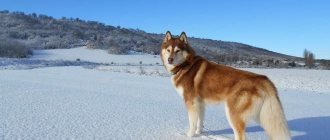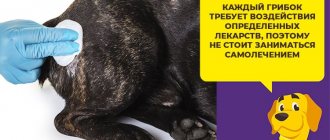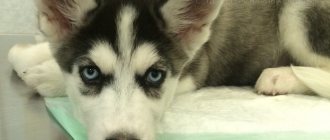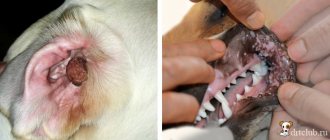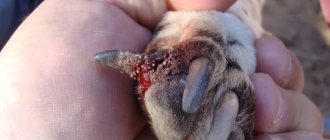Relaxing and therapeutic massage treatments are recommended not only for people, but also for pets. With their help, you can relieve muscle pain and even improve the functioning of the gastrointestinal tract. If you don’t know how to massage dogs, then you don’t have to constantly go to a veterinary clinic for this service. With enough practice, you can master the technique yourself.
When is massage indicated for a dog?
The procedure is carried out for therapeutic and preventive purposes. In the first case, it is prescribed in the presence of the following pathologies:
- Nervous disorders
. Massage actions relax the body, calming the nervous system. This helps to cope with stress and exciting events.
- Various pain syndromes
. Thanks to the stimulating effect, histamine production in the subcutaneous tissue improves. All spasmodic vessels dilate, so existing pain subsides or disappears completely.
- Injuries
. Stimulation of blood circulation improves metabolism, accelerating the regeneration of damaged tissues.
- Constipation
. The technique used improves intestinal motility, facilitating bowel movements.
- Diseases of the musculoskeletal system
(joint degeneration, paralysis). Stimulation of motor nerves and strengthening of muscle tissue make it easier for a sick animal to move, helping to restore lost function.
If the dog is completely healthy, then it is recommended to massage it for preventive purposes. Regular sessions will help maintain healthy bones and muscles until old age, as well as relieve fatigue accumulated during the day.
Massaging the limbs
Massage of the hind legs of dogs is done for paralysis and weakness of the muscles of the limbs. This procedure is an important part of rehabilitation. It stimulates nerve endings and develops muscles. This helps restore normal limb mobility.
To achieve the desired effect, your dog's paws must be massaged regularly. Treatment should continue for at least 20 minutes a day. To achieve the result, about 20 procedures will be required. Then they take a break for 14 days and repeat the sessions.
How to massage your dog's paws? It is necessary to give preference to kneading and vibration effects. This helps stimulate and restore nerves and muscles.
Use the following massage technique:
- Pet the dog's entire body. Try not to lift your hands while doing this. Your pet should be completely relaxed and calm.
- Gently pat the paw. Move from the base to the heels. Then slowly bend and straighten the limb. Repeat this movement 5 times.
- Massage your paw in a circular motion. First move to the inner surface of the limb, and then to the outer. Repeat the massage movements three times.
- Rub your paw muscles well. Gradually increase the intensity of the impact, but do not overdo it. Gently massage your heels and spaces between your toes.
After massaging one paw, move on to the other. Using this technique, you can massage both the hind and forelimbs. If you repeat the sessions regularly, your paws will regain strength. Gradually, your pet will learn to walk again.
Types of massage
Depending on the goal being pursued, several techniques are distinguished. They can be divided into 3 large groups:
- Relaxing
. Suitable for relieving nervous tension and deep relaxation. All actions performed are focused on the spine area.
- Preventive
(wellness). Aimed at improving muscle tone and increasing the elasticity of joints and ligaments. This type is suitable for preventing chronic diseases and maintaining overall health.
- Medicinal
(rehabilitation). This group includes all varieties recommended for recovery after operations, injuries and diseases of the musculoskeletal system. With their help, the animal returns to its normal life.
Separately, it is worth highlighting the cosmetic appearance offered in grooming salons. It is a combination of a complex of care procedures and relaxing massage movements.
All of the above techniques can be performed at home. The only difficulty may arise with hydromassage, a type of medical procedure. It is carried out only in a limited number of veterinary clinics equipped with a special bath for ozone therapy.
Are there any contraindications?
Like any medical procedure, massage for dogs has a number of contraindications. These include the following conditions:
- any skin lesions (neoplasms, open wounds, inflammation, ulcers, eczema);
- fresh fractures with severe pain;
- acute or advanced kidney and liver diseases;
- heat;
- bleeding;
- epilepsy or shock.
Please note that even in the absence of the listed contraindications, you should consult a veterinarian before starting home sessions. He will not only select a more effective technique, but also explain its main nuances.
Causes of limb problems
There are many causes of musculoskeletal diseases in dogs. These are injuries, untreated infectious diseases, excess weight, metabolic disorders, poor quality nutrition, excessive physical activity, etc.
All these factors provoke the development of chronic diseases that require high-quality, timely treatment.
Next, I will describe the main diseases leading to paralysis of the hind limbs.
Damage
Massage is necessary for fractures and mechanical injuries
. Mechanical injuries that can damage motor functions: fractures, tendon ruptures, sprains, nerve damage. They can occur due to strong impacts, falls from great heights, or bites from other animals.
Arthrosis
Arthrosis and arthritis are inflammatory diseases of the joints. If left untreated, they are characterized by severe pain and the dog’s inability to move independently.
Tumor
Neoplasms in the tissues of the paws or spinal column impair blood circulation and innervation of the limbs, which leads to insufficient nutrition of tissue structures and their subsequent degeneration.
Vertebral degenerative diseases
They are characterized by metabolic disorders in the tissues of the spine and subsequent degenerative changes in its structures.
Spondylosis
If your dog has spondylosis, massage is also recommended.
A disease of the spinal column characterized by a chronic course. It manifests itself as a spiky growth of bone tissue along the edges of the vertebral bodies.
Because of this, the lumen of blood vessels in the spine decreases, which impairs the nutrition of tissues and causes their degeneration, and has a negative effect on the nerves and tendons in the damaged area. Accompanied by severe pain.
Osteochondrosis
The disease manifests itself in the form of degeneration of cartilage tissue, usually in the intervertebral discs. Leads to acute pain, deterioration of blood circulation and innervation of the limbs.
Techniques for different types of massage
The massage movements used for four-legged pets are softer. Excessive force can cause harm, so it is important not only to time your efforts, but also to understand the peculiarities of canine physiology and anatomy.
Despite some differences, all available types involve the following hand movements:
- strokes that relax the body;
- fingertip tapping to help warm up the body at the very beginning;
- twisting, kneading tissue under the skin;
- rubbing, increasing blood flow and eliminating adhesions;
- compression (shaking) to relieve muscle spasms.
To obtain the desired results, you must devote at least 10 minutes to the procedure every day. At first, you should choose the minimum time to allow the animal to get used to unusual actions. If dissatisfaction appears (trembling, growling), it is recommended to stop the session.
Relaxing
First, prepare a flat surface by covering a table or regular floor with a soft cloth. You can put a muzzle on an aggressive pet, but you still shouldn’t abuse this accessory for a long time. Your pet should enjoy the session, so do not force him against his will.
After preparing a comfortable place, use the step-by-step algorithm that explains how to massage dogs:
- Start with light strokes. Use your fingertips and the inside of your palm to move around your entire body. Scratch the scruff of the neck and be sure to praise your pet so that he feels safe and as relaxed as possible.
- Massage your neck in a circular motion, moving from top to bottom. Perform all movements smoothly so as not to damage the vertebrae.
- Knead your ears and surrounding area. Be careful. The area between the ears is especially sensitive, as there are many nerve endings there.
- Using similar circular movements, stretch your shoulders and rotate the ponytail around its axis three times in different directions.
- Complete the procedure by stroking, moving from the back of the head to the tail.
Despite interaction with a rather limited number of areas (ears, withers, back, tail), relaxation occurs throughout the body. This occurs thanks to the neurons of the spinal column, which transmit signals even to the most distant areas.
Anesthetic
The technique for performing this type is similar to a relaxing massage for dogs, focusing on the back. The only difference is that the working area will depend on the location of the source of pain.
Use stroking, rubbing and light twisting, but do not directly affect the source of pain. You should also avoid contact with existing tumors. Stimulating blood circulation can affect their growth.
If your pet's paws hurt, use the tips recommended for paralysis. In other cases, you can adhere to the relaxation technique algorithm.
Medicinal
The technique for performing this type depends on the problem at hand. It is prescribed for constipation, paralysis, recent stroke, mastitis, dysplasia, arthritis and other pathologies.
If your pet has been diagnosed with a disease that requires a course of massage sessions, discuss this issue with your veterinarian. He will explain which area should be given the most attention and with what force it is permissible to massage problem areas.
For good peristalsis
Immediately after birth, the mother monitors peristalsis, regularly kneading the babies’ tummies with her paws and tongue. But intestinal problems bother dogs even at an older age. At this point, taking care of their health falls entirely on the owner.
To prevent constipation, you need to regularly massage your sides and stomach, moving clockwise. Start the procedure with light circular strokes at the chest and smoothly move towards the tail, gradually increasing the diameter of the working area and the intensity of palpation. The appearance of gurgling sounds during the procedure is a normal reaction, confirming the effectiveness of the therapy used.
Avoid putting too much pressure on the abdominal wall. It can damage internal organs. It is also recommended not to touch the groin area. Such touches cause a negative reaction in most animals.
For paralysis
For problems with the musculoskeletal system, it is recommended to focus on twisting and shaking. With their help, you can restore damaged muscles and nerves.
During the session, do the following:
- Calm your pet with light stroking of the entire body. Move to the paws as soon as he relaxes.
- Stroke one of the sore limbs, moving from its base straight to the heels. Gently bend it at the elbow or knee. Return the paw to its original position and repeat the previous action 4 more times.
- Massage the limb in a circular motion, moving from the inner surface to the outer. Having reached your heels, repeat the above steps 3 more times.
- Rub your hand or foot vigorously, not forgetting the space between your toes. Control the force used so as not to harm the animal.
After massaging one of your dog's paws, immediately move on to the other. Please note that it is necessary to act not only on the sore limb, but on everything at once.
Linda Tellington-Jones method
Read also:
Dogs for children: dreams come true!
How often can you hear from owners of four-legged dogs: “My dog shudders at every sharp sound, he can hardly bear stress, is very overexcited and can even show unjustified aggression. I can’t imagine what to do with this.”
There are many ways to overcome such problems. Let's focus on one of them - the method of honorary Doctor of Philosophy, veterinary physiotherapist with forty years of experience, trainer, teacher, winner of many awards and prizes Linda Tellington-Jones.
Her unique way of working with animals (initially horses and then other animals), called T-Touch, was developed in 1983. It makes it possible not only to relieve stress in dogs, allowing them to feel differently at home and during classes or walks, but also to build a more trusting relationship between man and animal.

